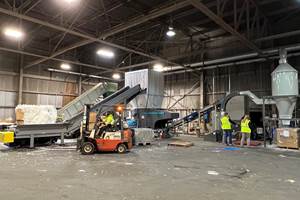If You Like Wrestling with Carbon Footprints…
A couple of suppliers recently calculated their carbon footprints for producing injection molding machines and tooling.

Arburg calculated the embedded energy consumption and carbon emissions for around 11,000 components of its injection machines, comprising eight different materials categories. (Photo: Arburg)
Back in June, I outlined the daunting complexities of calculating carbon footprints for either a production plant (“site carbon footprint”) or a plastic product (“product carbon footprint”). My brief overview of the subject was based on a new book, Sustainability Management in Plastics Processing, by consultant Dr. Robin Kent. Among the long list of factors contributing to greenhouse-gas emissions in plastics processing, one that was not discussed was the energy consumption embodied in the production of the processing machinery and tooling used to make your plastics products. As noted by Dr. Kent, these are indeed included in the “Corporate Value Chain Accounting and Reporting Standard” of the international Greenhouse Gas Protocol, but he limited his discussion in the book to “the emissions over which a site has a reasonable degree of control.”
Two familiar names have recently come forward to help fill that gap. As reported in detail by my colleague, Executive Editor Tony Deligio, Arburg has used the ISO TS 1467-2018 standard to calculate the product carbon footprint of its injection molding machines. Arburg points out that those machines can be considered part of your operation’s Scope 3 emissions – which include indirect emissions from upstream and downstream business practices in the GHG Protocol.
Arburg had to account not only for the energy used in its own machine-building operations, but also the embodied energy in the roughly 11,000 components, sorted into eight distinct materials groups, along with consideration of where those components were made. Arburg emphasizes that the carbon footprint of building an injection press is dwarfed by the emissions involved in using the press over its lifetime – but that was already covered by Dr. Kent in his discussion of a processing plant’s carbon footprint. (He warns that carbon accounting must be rigorous to avoid “double counting.”)

Haidlmair says it can determine the carbon footprint of each injection mold it builds -- encompassing the steel, machining and upstream and downstream transportation. (Photo: Haidlmair)
Then, in August, the large Austrian moldmaker Haidmair announced that it is now able to determine the exact carbon footprint for each mold it manufactures. This includes data from the steel production, its own machining operations, and the upstream and downstream transportation of components and finished injection molds.
(You’ll be able to ask Arburg and Haidlmair about these calculations at the upcoming K 2022 show, Oct. 19-26 in Düsseldorf, where both will be exhibiting and emphasizing their attention to sustainability.)
That’s not the end of Scope 3 emissions counting, not by a long shot. There’s also the factory and warehouse buildings. I have not delved into those complexities myself, so I can only wonder whether, for example, you would get a pass if you moved into an existing building. But you must have made some changes or improvements – a new floor, perhaps, a paint job, upgraded utilities, or maybe a rail siding or storage silo. What of those? And what happens when you add on a new wing or other structure?
Contemplating all this certainly does open your eyes to the simple fact that everything consumes energy. But I’m pretty confident that when you compare plastics manufacturing with production of steel, glass or paper products, and the amounts of machinery involved, square feet of plant to house it, and the embodied energy in all that – the end result of calulating and estimating will solidly favor plastics after all.
Related Content
Purpose-Built System Enhances Capacity and Flexibility for Recycler
A Boston recycler invested in a turnkey shredding, granulation and elutriation system to expand its plastics reclaim business.
Read MoreThe Importance of Mass Balance in Chemical Recycling
Approaches to mass balance can dramatically impact calculations of recycled content.
Read MorePHA Compound Molded into “World’s First” Biodegradable Bottle Closures
Beyond Plastic and partners have created a certified biodegradable PHA compound that can be injection molded into 38-mm closures in a sub 6-second cycle from a multicavity hot runner tool.
Read MoreHow to Optimize Injection Molding of PHA and PHA/PLA Blends
Here are processing guidelines aimed at both getting the PHA resin into the process without degrading it, and reducing residence time at melt temperatures.
Read MoreRead Next
People 4.0 – How to Get Buy-In from Your Staff for Industry 4.0 Systems
Implementing a production monitoring system as the foundation of a ‘smart factory’ is about integrating people with new technology as much as it is about integrating machines and computers. Here are tips from a company that has gone through the process.
Read MoreSee Recyclers Close the Loop on Trade Show Production Scrap at NPE2024
A collaboration between show organizer PLASTICS, recycler CPR and size reduction experts WEIMA and Conair recovered and recycled all production scrap at NPE2024.
Read More
























